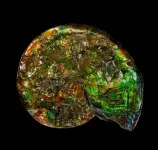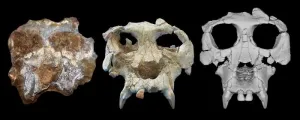(Press-News.org) A paper in the prestigious Proceedings of the National Academy of Sciences today describes “a missing law of nature,” recognizing for the first time an important norm within the natural world’s workings.
In essence, the new law states that complex natural systems evolve to states of greater patterning, diversity, and complexity. In other words, evolution is not limited to life on Earth, it also occurs in other massively complex systems, from planets and stars to atoms, minerals, and more.
Authored by a nine-member team — leading scientists from the Carnegie Institution for Science, the California Institute of Technology (Caltech) and Cornell University, and philosophers from the University of Colorado — the work was funded by the John Templeton Foundation.
“Macroscopic” laws of nature describe and explain phenomena experienced daily in the natural world. Natural laws related to forces and motion, gravity, electromagnetism, and energy, for example, were described more than 150 years ago.
The new work presents a modern addition — a macroscopic law recognizing evolution as a common feature of the natural world’s complex systems, which are characterised as follows:
They are formed from many different components, such as atoms, molecules, or cells, that can be arranged and rearranged repeatedly
Are subject to natural processes that cause countless different arrangements to be formed
Only a small fraction of all these configurations survive in a process called “selection for function.”
Regardless of whether the system is living or nonliving, when a novel configuration works well and function improves, evolution occurs.
The authors’ “Law of Increasing Functional Information” states that the system will evolve “if many different configurations of the system undergo selection for one or more functions.”
“An important component of this proposed natural law is the idea of ‘selection for function,’” says Carnegie astrobiologist Dr. Michael L. Wong, first author of the study.
In the case of biology, Darwin equated function primarily with survival—the ability to live long enough to produce fertile offspring.
The new study expands that perspective, noting that at least three kinds of function occur in nature.
The most basic function is stability – stable arrangements of atoms or molecules are selected to continue. Also chosen to persist are dynamic systems with ongoing supplies of energy.
The third and most interesting function is “novelty”—the tendency of evolving systems to explore new configurations that sometimes lead to startling new behaviors or characteristics.
Life's evolutionary history is rich with novelties—photosynthesis evolved when single cells learned to harness light energy, multicellular life evolved when cells learned to cooperate, and species evolved thanks to advantageous new behaviors such as swimming, walking, flying, and thinking.
The same sort of evolution happens in the mineral kingdom. The earliest minerals represent particularly stable arrangements of atoms. Those primordial minerals provided foundations for the next generations of minerals, which participated in life’s origins. The evolution of life and minerals are intertwined, as life uses minerals for shells, teeth, and bones.
Indeed, Earth’s minerals, which began with about 20 at the dawn of our Solar System, now number almost 6,000 known today thanks to ever more complex physical, chemical, and ultimately biological processes over 4.5 billion years.
In the case of stars, the paper notes that just two major elements – hydrogen and helium – formed the first stars shortly after the big bang. Those earliest stars used hydrogen and helium to make about 20 heavier chemical elements. And the next generation of stars built on that diversity to produce almost 100 more elements.
“Charles Darwin eloquently articulated the way plants and animals evolve by natural selection, with many variations and traits of individuals and many different configurations,” says co-author Robert M. Hazen of Carnegie Science, a leader of the research.
“We contend that Darwinian theory is just a very special, very important case within a far larger natural phenomenon. The notion that selection for function drives evolution applies equally to stars, atoms, minerals, and many other conceptually equivalent situations where many configurations are subjected to selective pressure.”
The co-authors themselves represent a unique multi-disciplinary configuration: three philosophers of science, two astrobiologists, a data scientist, a mineralogist, and a theoretical physicist.
Says Dr. Wong: “In this new paper, we consider evolution in the broadest sense—change over time—which subsumes Darwinian evolution based upon the particulars of ‘descent with modification.’”
“The universe generates novel combinations of atoms, molecules, cells, etc. Those combinations that are stable and can go on to engender even more novelty will continue to evolve. This is what makes life the most striking example of evolution, but evolution is everywhere.”
Among many implications, the paper offers:
Understanding into how differing systems possess varying degrees to which they can continue to evolve. “Potential complexity” or “future complexity” have been proposed as metrics of how much more complex an evolving system might become
Insights into how the rate of evolution of some systems can be influenced artificially. The notion of functional information suggests that the rate of evolution in a system might be increased in at least three ways: (1) by increasing the number and/or diversity of interacting agents, (2) by increasing the number of different configurations of the system; and/or 3) by enhancing the selective pressure on the system (for example, in chemical systems by more frequent cycles of heating/cooling or wetting/drying).
A deeper understanding of generative forces behind the creation and existence of complex phenomena in the universe, and the role of information in describing them
An understanding of life in the context of other complex evolving systems. Life shares certain conceptual equivalencies with other complex evolving systems, but the authors point to a future research direction, asking if there is something distinct about how life processes information on functionality (see also https://royalsocietypublishing.org/doi/10.1098/rsif.2022.0810).
Aiding the search for life elsewhere: if there is a demarcation between life and non-life that has to do with selection for function, can we identify the "rules of life" that allow us to discriminate that biotic dividing line in astrobiological investigations? (See also https://conta.cc/3LwLRYS, “Did Life Exist on Mars? Other Planets? With AI’s Help, We May Know Soon”)
At a time when evolving AI systems are an increasing concern, a predictive law of information that characterizes how both natural and symbolic systems evolve is especially welcome
Laws of nature – motion, gravity, electromagnetism, thermodynamics – etc. codify the general behavior of various macroscopic natural systems across space and time.
The “law of increasing functional information” published today complements the 2nd law of thermodynamics, which states that the entropy (disorder) of an isolated system increases over time (and heat always flows from hotter to colder objects).
* * * * *
Comments
"This is a superb, bold, broad, and transformational article. ... The authors are approaching the fundamental issue of the increase in complexity of the evolving universe. The purpose is a search for a ‘missing law’ that is consistent with the known laws.
"At this stage of the development of these ideas, rather like the early concepts in the mid-19th century of coming to understand ‘energy’ and ‘entropy,’ open broad discussion is now essential."
Stuart Kauffman
Institute for Systems Biology, Seattle WA
“The study of Wong et al. is like a breeze of fresh air blowing over the difficult terrain at the trijunction of astrobiology, systems science and evolutionary theory. It follows in the steps of giants such as Erwin Schrödinger, Ilya Prigogine, Freeman Dyson and James Lovelock. In particular, it was Schrödinger who formulated the perennial puzzle: how can complexity increase -- and drastically so! -- in living systems, while they remain bound by the Second Law of thermodynamics? In the pile of attempts to resolve this conundrum in the course of the last 80 years, Wong et al. offer perhaps the best shot so far.”
“Their central idea, the formulation of the law of increasing functional information, is simple but subtle: a system will manifest an increase in functional information if its various configurations generated in time are selected for one or more functions. This, the authors claim, is the controversial ‘missing law’ of complexity, and they provide a bunch of excellent examples. From my admittedly quite subjective point of view, the most interesting ones pertain to life in radically different habitats like Titan or to evolutionary trajectories characterized by multiple exaptations of traits resulting in a dramatic increase in complexity. Does the correct answer to Schrödinger's question lie in this direction? Only time will tell, but both my head and my gut are curiously positive on that one. Finally, another great merit of this study is worth pointing out: in this day and age of rabid Counter-Enlightenment on the loose, as well as relentless attacks on the freedom of thought and speech, we certainly need more unabashedly multidisciplinary and multicultural projects like this one.”
Milan Cirkovic
Astronomical Observatory of Belgrade, Serbia; The Future of Humanity Institute, Oxford University
The natural laws we recognize today cannot yet account for one astounding characteristic of our universe—the propensity of natural systems to “evolve.” As the authors of this study attest, the tendency to increase in complexity and function through time is not specific to biology, but is a fundamental property observed throughout the universe. Wong and colleagues have distilled a set of principles which provide a foundation for cross-disciplinary discourse on evolving systems. In so doing, their work will facilitate the study of self-organization and emergent complexity in the natural world.
Corday Selden
Department of Marine and Coastal Sciences, Rutgers University
The paper "On the roles of function and selection in evolving systems" provides an innovative, compelling, and sound theoretical framework for the evolution of complex systems, encompassing both living and non-living systems. Pivotal in this new law is functional information, which quantitatively captures the possibilities a system has to perform a function. As some functions are indeed crucial for the survival of a living organism, this theory addresses the core of evolution and is open to quantitative assessment. I believe this contribution has also the merit of speaking to different scientific communities that might find a common ground for open and fruitful discussions on complexity and evolution.
Andrea Roli
Assistant Professor, Università di Bologna.
* * * * *
“On the roles of function and selection in evolving systems,”
Authors:
Michael L. Wong 1,2, Carol E. Cleland 3, Daniel Arends Jr. 3, Stuart Bartlett 4, H. James Cleaves II 1,5,6, Heather Demarest 3, Anirudh Prabhu1, Jonathan I. Lunine 7, and Robert M. Hazen 1
1 Earth and Planets Laboratory, Carnegie Institution for Science, Washington, DC 20015, USA
2 NHFP Sagan Fellow, NASA Hubble Fellowship Program, Space Telescope Science Institute,
Baltimore, MD 21218, USA
3 Department of Philosophy, University of Colorado Boulder, Boulder, CO 80309, USA
4 Division of Geological and Planetary Sciences, California Institute of Technology, Pasadena, CA 91125, USA
5 Earth Life Science Institute, Tokyo Institute of Technology, Tokyo, Japan
6 Blue Marble Space Institute for Science, Seattle, WA 98104, USA
7 Department of Astronomy and Carl Sagan Institute, Cornell University, Ithaca, NY 14853 USA
* * * * *
About Carnegie Science
https://carnegiescience.edu/about
* * * * *
END
Leading scientists, philosophers identify nature’s missing evolutionary law
Evolution of plants, animals: “A very special case within a far larger natural phenomenon.” Similar marvels occur with stars, planets, minerals, other complex systems; When a novel configuration works well and function improves, evolution occurs
2023-10-16
ELSE PRESS RELEASES FROM THIS DATE:
Study shows long-term health impacts after exposure to environmental disaster
2023-10-16
Exposure to a large-scale disaster, such as a tsunami, impacts population health over a decade later. A new study by an inter-disciplinary team of researchers in the United States and Indonesia has found that women who lived along the coast of Aceh, Indonesia when it was hit by waves from the 2004 tsunami have lower cortisol levels 14 years later than women who lived in other, nearby coastal communities that were not directly affected.
Cortisol is a stress hormone produced by the adrenal glands. Cortisol levels rise in response to stress as part of the fight or flight response, but consistently elevated ...
Extinct ape gets a facelift, 12 million years later
2023-10-16
A new study led by scientists at the American Museum of Natural History, Brooklyn College, and the Catalan Institute of Paleontology Miquel Crusafont has reconstructed the well-preserved but damaged skull of a great ape species that lived about 12 million years ago. The species, Pierolapithecus catalaunicus, may be crucial to understanding great ape and human evolution. The researchers describe their findings today in the journal Proceedings of the National Academy of Sciences.
Pierolapithecus catalaunicus, a species from northeastern Spain first described in 2004, was one of a diverse group of now-extinct ...
Signatures of the Space Age: Spacecraft metals left in the wake of humanity’s path to the stars
2023-10-16
WEST LAFAYETTE, Ind. – The Space Age is leaving fingerprints on one of the most remote parts of the planet — the stratosphere — which has potential implications for climate, the ozone layer and the continued habitability of Earth.
Using tools hitched to the nose cone of their research planes and sampling more than 11 miles above the planet’s surface, researchers have discovered significant amounts of metals in aerosols in the atmosphere, likely from increasingly frequent launches and returns of spacecraft and satellites. That mass of metal is changing atmospheric chemistry in ways that ...
Stress levels worse in women who have heart attacks with blockages, study finds
2023-10-16
Stress and depression are known to increase risk of heart attack, especially among women. They’ve also been linked to worse recovery. But does stress and depression contribute more to women with heart attacks with open arteries or blocked arteries? That’s what a new study published in the Journal of the American College of Cardiology aimed to find out.
Researchers found stress and depression were indeed common among women at the time of heart attack and for two months after. But they also found that women with heart attacks due to blockages (MI-CAD) in their coronary arteries had higher ...
The new robot is taking its first intuitive steps
2023-10-16
When walking on the sidewalk, a person is able to avoid puddles, other walkers, and cracks in the pavement. It may seem intuitive – and that's because it is.
There’s actually a biological component that allows humans and other mammals to navigate our complex environments. Central Pattern Generators (CPG) are neural networks that produce rhythmic patterns of control signals for limbs using simple environmental cues. When we quickly step away to avoid something blocking our path, that’s ...
Neutrons see stress in 3D-printed parts, advancing additive manufacturing
2023-10-16
Using neutrons to see the additive manufacturing process at the atomic level, scientists have shown that they can measure strain in a material as it evolves and track how atoms move in response to stress.
The automotive, aerospace, clean energy and tool-and-die industries — any industry that needs complex and high-performance parts — could use additive manufacturing,” said Alex Plotkowski, materials scientist in ORNL’s Materials Science and Technology Division and the lead scientist of the experiment. Plotkowski and his ...
How to tell if your boss is a ‘corporate psychopath’
2023-10-16
Findings from research to help the business world identify destructive ‘corporate psychopaths’ will be presented at the Chelmsford Science Festival on Monday, 23 October.
Dr Clive Boddy of Anglia Ruskin University, a pioneer in the field of corporate psychopathy, will discuss his research, published in the International Journal of Market Research, looking at how the financial industry can identify, manage and, if necessary, remove these individuals.
Around 1% of the adult population are ...
Ochsner Health Recipient of the 2023-24 WebMD Choice Awards
2023-10-16
NEW ORLEANS, La. - Ochsner Health was named among the “Best Hospitals According to Patients & Health Care Providers” by WebMD, an online publication for health news and information.
The 2023 WebMD Choice Awards recognized a select group of 167 health systems with Elite Choice Awards, WebMD Patient Choice Awards, and Medscape Physician Choice Awards. Results were gathered via a survey of a national audience encompassing thousands of patients and healthcare clinicians to determine which hospitals they believe deliver the best quality and treatments. The awards program identifies the “best in class” ...
Carnegie Mellon University's Synergy Lab releases three papers on ubiquitous sensing
2023-10-16
Researchers from Carnegie Mellon's Systems, Networking, and Energy Efficiency (Synergy) Lab will present several multi-year studies on their work around ubiquitous sensing at this week's ACM International Joint Conference on Pervasive and Ubiquitous Computing (UbiComp).
The works unveil several innovative systems and explain how the collected data can be converted to offer useful insights, all while ensuring the privacy of the individuals being monitored.
Led by School of Computer Science Associate Professor Yuvraj Agarwal, ...
Insilico Medicine presents data on AI-designed cancer drugs at 3 major cancer conferences
2023-10-16
Clinical stage artificial intelligence (AI) drug discovery company Insilico Medicine (“Insilico”) has been invited to present scientific data on its novel anti-cancer assets at three major upcoming cancer conferences -- the European Society for Medical Oncology (ESMO) conference in Madrid Oct. 20-24, 2023; the Society of Immunotherapy of Cancer (SITC) conference Nov. 1-5, 2023 in San Diego; and the San Antonio Breast Cancer Symposium (SABCS) Dec. 5-9, 2023.
Small molecule oncology ...
LAST 30 PRESS RELEASES:
New expert guidance urges caution before surgery for patients with treatment-resistant constipation
Solar hydrogen can now be produced efficiently without the scarce metal platinum
Sleeping in on weekends may help boost teens’ mental health
Study: Teens use cellphones for an hour a day at school
After more than two years of war, Palestinian children are hungry, denied education and “like the living dead”
The untold story of life with Prader-Willi syndrome - according to the siblings who live it
How the parasite that ‘gave up sex’ found more hosts – and why its victory won’t last
When is it time to jump? The boiling frog problem of AI use in physics education
Twitter data reveals partisan divide in understanding why pollen season's getting worse
AI is quick but risky for updating old software
Revolutionizing biosecurity: new multi-omics framework to transform invasive species management
From ancient herb to modern medicine: new review unveils the multi-targeted healing potential of Borago officinalis
Building a global scientific community: Biological Diversity Journal announces dual recruitment of Editorial Board and Youth Editorial Board members
Microbes that break down antibiotics help protect ecosystems under drug pollution
Smart biochar that remembers pollutants offers a new way to clean water and recycle biomass
Rice genes matter more than domestication in shaping plant microbiomes
Ticking time bomb: Some farmers report as many as 70 tick encounters over a 6-month period
Turning garden and crop waste into plastics
Scientists discover ‘platypus galaxies’ in the early universe
Seeing thyroid cancer in a new light: when AI meets label-free imaging in the operating room
Neutrophil-to-lymphocyte ratio may aid risk stratification in depressive disorder
2026 Seismological Society of America Annual Meeting
AI-powered ECG analysis offers promising path for early detection of chronic obstructive pulmonary disease, says Mount Sinai researchers
GIMM uncovers flaws in lab-grown heart cells and paves the way for improved treatments
Cracking the evolutionary code of sleep
Medications could help the aging brain cope with surgery, memory impairment
Back pain linked to worse sleep years later in men over 65, according to study
CDC urges ‘shared decision-making’ on some childhood vaccines; many unclear about what that means
New research finds that an ‘equal treatment’ approach to economic opportunity advertising can backfire
Researchers create shape-shifting, self-navigating microparticles
[Press-News.org] Leading scientists, philosophers identify nature’s missing evolutionary lawEvolution of plants, animals: “A very special case within a far larger natural phenomenon.” Similar marvels occur with stars, planets, minerals, other complex systems; When a novel configuration works well and function improves, evolution occurs





